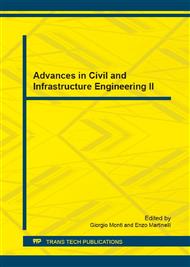[1]
NATIONAL RESEARCH COUNCIL (CNR), Guide for the design and construction of externally bonded FRP systems for strengthening existing structures, CNR-DT 200 R1/2013, Rome, Italy, October (2013).
Google Scholar
[2]
FÉDÉRATION INTERNATIONALE DU BÉTON, Externally bonded FRP reinforcement for RC structures, Fib Bulletin 14, Lausanne, Switzerland, July (2001).
DOI: 10.35789/fib.bull.0014.ch01
Google Scholar
[3]
AMERICAN CONCRETE INSTITUTE (ACI), Guide for the design and construction of externally bonded FRP systems for strengthening of concrete structure, ACI 440. 2R-08, Farmington Hill, USA, July (2008).
DOI: 10.14359/51700867
Google Scholar
[4]
HARTIG, J., JESSE, F., SCHICKTANZ, K., HÄUßLER-COMBE, U., Influence of experimental setups on the apparent uniaxial tensile load-bearing capacity of textile reinforcement concrete specimens, Materials and Structures, Vol. 45, 2011, p.433–446.
DOI: 10.1617/s11527-011-9775-0
Google Scholar
[5]
TRIANTAFILLOU, T.C., PAPANICOLAOU, C.G., ZISSINOPOULOS, P., LAOURDEKIS, T., Concrete confinement with textile-reinforced mortar jackets, ACI Structural Journal, Vol. 1, No. 103, 2006, p.28–37.
DOI: 10.14359/15083
Google Scholar
[6]
PELLEGRINO, C., D'ANTINO, T., Experimental behaviour of existing precast prestressed reinforced concrete elements strengthened with cementitious composites, Composite Part B: Engineering, Vol. 55, 2013, p.31–40.
DOI: 10.1016/j.compositesb.2013.05.053
Google Scholar
[7]
OMBRES, L., Debonding analysis of reinforced concrete beams strengthened with fibre reinforced cementitious mortar, Engineering Fracture Mechanics, Vol. 81, 2012, pp.94-109.
DOI: 10.1016/j.engfracmech.2011.06.012
Google Scholar
[8]
BLANKSVÄRD, T., TÄLJSTEN, B., CAROLIN, A., Shear strengthening of concrete structures with the use of mineral-based composites, Journal of Composite for Construction, ASCE, Vol. 13, No. 1, 2009, p.25–34.
DOI: 10.1061/(asce)1090-0268(2009)13:1(25)
Google Scholar
[9]
TZOURA, E., TRIANTAFILLOU, T.C., Shear strengthening of reinforced concrete T-beams under cyclic loading with TRM or FRP jackets, Materials and Structures, 2014, DOI 10. 1617/s11527-014-0470-9.
DOI: 10.1617/s11527-014-0470-9
Google Scholar
[10]
BOURNAS, D.A., TRIANTAFILLOU, T.C., ZYGOURIS, K., STAVROPOULOS, F., Textile-reinforced mortar (TRM) versus FRP jacketing in seismic retrofitting of RC columns with continuous or lap-spliced deformed bars, Journal of Composite for Construction, Vol. 13, No. 5, 2009, p.360.
DOI: 10.1061/(asce)cc.1943-5614.0000028
Google Scholar
[11]
OMBRES, L., Concrete confinement with a cement based high strength composite material, Composite Structures, Vol. 109, 2014, pp.294-304.
DOI: 10.1016/j.compstruct.2013.10.037
Google Scholar
[12]
D'AMBRISI, A., FEO, L., FOCACCI, F., Experimental analysis on bond between PBO-FRCM strengthening materials and concrete, Composite Part B: Engineering, Vol. 44, No. 1, 2013, pp.524-532.
DOI: 10.1016/j.compositesb.2012.03.011
Google Scholar
[13]
SNEED, L.H., D'ANTINO, T., CARLONI, C., Investigation of bond behavior of PBO fiber-reinforced cementitious matrix composite-concrete interface,. ACI Material Journal, Vol. 111, No. 1-6, 2014, pp.1-12.
DOI: 10.14359/51686604
Google Scholar
[14]
D'ANTINO, T., PELLEGRINO, C., CARLONI, C., SNEED, L.H., Experimental analysis of the bond behavior of glass, carbon, and steel FRCM composites, Key Engineering Materials, Vol. 624, 2015, pp.371-378.
DOI: 10.4028/www.scientific.net/kem.624.371
Google Scholar
[15]
D'ANTINO, T., CARLONI, C., SNEED, L.H., PELLEGRINO, C., Matrix-fiber bond behavior in PBO FRCM composites: a fracture mechanics approach, Engineering Fracture Mechanics, Vol. 117, 2014, pp.94-111.
DOI: 10.1016/j.engfracmech.2014.01.011
Google Scholar
[16]
SUBRAMANIAM, K.V., CARLONI, C., NOBILE, L., Width effect in the interface fracture during debonding of FRP sheets from concrete, Engineering Fracture Mechanics, Vol. 74, 2007, pp.578-594.
DOI: 10.1016/j.engfracmech.2006.09.002
Google Scholar
[17]
ASTM INTERNATIONAL, Standard test method for tensile properties of polymer matrix composite materials, ASTM D3039/D3039M-08, West Conshohocken, USA, (2008).
Google Scholar
[18]
COMITÉ EUROPÉEN DE NORMALIZATION, Testing hardened concrete. Compressive strength of test specimens, UNI EN 12390-3, Brussels, Belgium, (2009).
Google Scholar
[19]
COMITÉ EUROPÉEN DE NORMALIZATION, Methods of test for mortar for masonry – Part 11: determination of flexural and compressive strength of hardened mortar, UNI EN 1015-11, Brussels, Belgium, (2007).
DOI: 10.3403/01905442
Google Scholar


